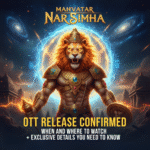Mahavatar Narsimha Movie Director:
- Ashwin Kumar: He is the director of this ambitious animated film. His direction, especially in bringing this mythological tale to life with such scale, has been noted by critics. The screenplay, which he also contributed to, along with Jayapurna Das and Rudra Pratap Ghosh, has been praised for its emotional depth and fidelity to the scriptures.
Cameraman (Director of Photography):
- While a specific “cameraman” isn’t typically listed in the same way for animated films as it is for live-action, the role is analogous to Director of Animation or Visual Development Lead who oversee the visual style and framing. The film’s cinematography (in terms of visual composition and grandeur) has been widely praised, contributing significantly to its impact. The visual effects (VFX) have been highlighted as stunning.
Lead Artists (Voice Cast):
- As an animated film, the “lead artists” are typically the voice actors who bring the characters to life. Specific names for the main voice cast (especially for characters like Prahlad, Hiranyakashipu, and Lord Narsimha) are often highlighted. For the Hindi version, Aditya Raj Sharma, Haripriya Matta, and Sanket Jaiswal have lent their voices.
Producers:
- The film is produced by Hombale Films (known for KGF and Kantara) in collaboration with Kleem Productions.
Plot Summary:
“Mahavatar Narsimha” retells the legendary tale from Hindu mythology, focusing on the fourth avatar of Lord Vishnu, Narsimha. The story centers on the demon king Hiranyakashipu, who obtains powerful boons making him seemingly invincible, and his devout son Prahlad, who remains unwavering in his devotion to Lord Vishnu despite his father’s tyranny. The film culminates in the divine appearance of the half-man, half-lion Narsimha, who restores cosmic balance by vanquishing Hiranyakashipu and ending his reign of terror.
Review (General Consensus):
“Mahavatar Narsimha” has emerged as a surprise box office success and a significant step forward for Indian animated cinema. It has garnered largely positive reviews, especially for its ambition, visual grandeur, and emotional depth.
- Strengths:
- Animation Quality: The film’s animation and VFX have received widespread praise for being “top-tier,” “jaw-dropping,” and “visually bold.” The depiction of Lord Narsimha’s entry and fight sequences are particularly highlighted as awe-inspiring.
- Storytelling: It offers a sincere and ambitious retelling of a well-known mythological story, focusing on themes of devotion, good versus evil, and divine intervention. The screenplay is noted for its scriptural fidelity and emotional resonance.
- Impact: Many viewers and critics have found it to be a powerful and inspiring experience, especially for family audiences and those interested in mythological tales. It’s seen as setting a new benchmark for Indian animated films.
- Music: The background music and chanting are reported to enhance the spiritual and immersive experience.
- Areas for Improvement (Minor Criticisms):
- Consistency in Animation: While largely praised, some reviewers noted occasional inconsistencies or a lack of smoothness in certain animated sequences compared to global animation standards.
- Pacing: Like many mythological narratives, the pacing might feel uneven at times for some viewers.
- Familiarity of the Tale: For those already well-versed in the story of Narsimha and Prahlad, the plot itself offers few surprises, but its visual presentation is what sets it apart.
Overall, “Mahavatar Narsimha” is hailed as a cinematic triumph that beautifully brings a revered mythological epic to life through high-quality animation. It’s a must-watch for its visual spectacle, emotional narrative, and its potential to inspire a new wave of Indian animated films.















